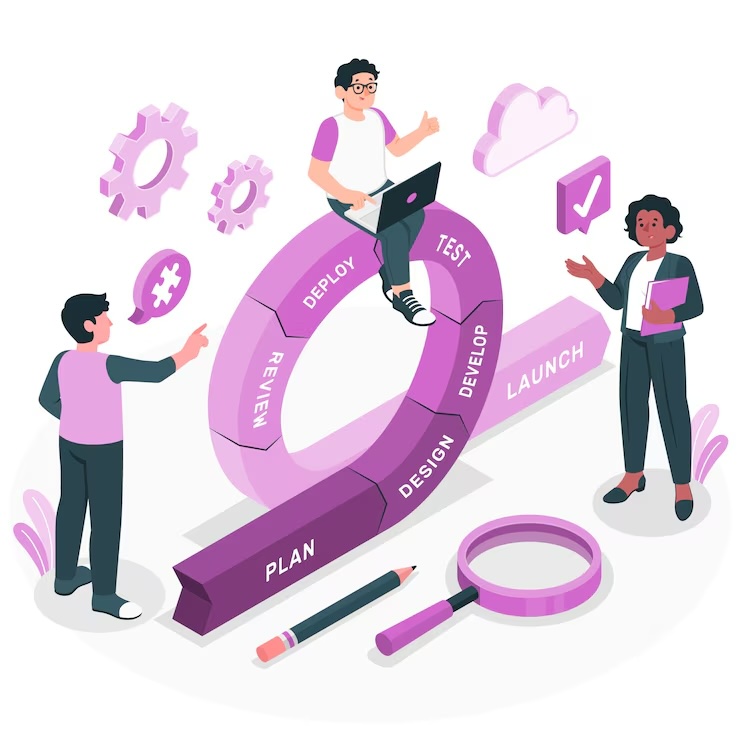Our Development Process
We adapt our approach to fit your project's unique requirements, using proven methodologies to deliver exceptional results.
Tailored Development Approaches
At Clever Applications, we understand that every project is unique, with its own set of requirements, constraints, and objectives. That's why we don't believe in a one-size-fits-all approach to software development.
Instead, we carefully select the most appropriate development methodology based on your specific needs, project scope, timeline, and budget. Our team is proficient in a wide range of development approaches, from traditional Waterfall to modern Agile methodologies.
This flexibility allows us to optimize the development process for each project, ensuring efficient use of resources, timely delivery, and high-quality results that meet or exceed your expectations.

Our Development Methodologies
We employ a variety of proven development methodologies, selecting the most appropriate approach for each project's unique requirements.
Waterfall
A sequential approach where each phase must be completed before the next begins. This methodology is ideal for projects with well-defined requirements and minimal expected changes.
Clear structure with distinct phases: requirements, design, implementation, verification, and maintenance
Comprehensive documentation at each stage ensures clarity and knowledge transfer
Ideal for projects with fixed requirements, clear deliverables, and predictable timelines
Prototyping
An approach that focuses on developing an initial version of the system to validate concepts and gather feedback before full-scale development begins.
Early visualization of the system helps clarify requirements and identify potential issues
Facilitates user feedback early in the development process, reducing the risk of misaligned expectations
Particularly valuable for innovative projects or when requirements are not fully understood
Iterative and Incremental Development
A methodology that involves developing the system through repeated cycles (iterations) and in smaller portions (increments), allowing for refinement based on feedback.
Delivers functional components of the system in stages, providing value earlier in the project lifecycle
Allows for continuous improvement based on feedback from previous iterations
Reduces risk by identifying and addressing issues early in the development process
Spiral Development
A risk-driven model that combines elements of both design and prototyping in stages, allowing for incremental releases and refinement.
Emphasizes risk assessment and mitigation throughout the development process
Combines elements of waterfall and iterative development for a balanced approach
Well-suited for large, complex projects with significant risk factors
Rapid Application Development (RAD)
A methodology that prioritizes rapid prototyping and quick feedback over extensive planning, enabling faster development and delivery.
Minimizes planning time and maximizes development time for faster delivery
Utilizes workshops and focus groups to gather requirements and feedback
Ideal for projects with tight deadlines or when quick deployment is a priority
Agile
An iterative approach that emphasizes flexibility, customer collaboration, and rapid delivery of functional software in short cycles called sprints.
Embraces change and adapts to evolving requirements throughout the development process
Promotes close collaboration between cross-functional teams and stakeholders
Delivers working software in short iterations, providing tangible value throughout the project
Includes methodologies like Scrum and Kanban, which provide frameworks for implementing Agile principles
Extreme Programming (XP)
A specific Agile methodology that emphasizes technical excellence, frequent releases, and close customer involvement to deliver high-quality software.
Implements practices like pair programming, test-driven development, and continuous integration
Emphasizes simplicity, communication, feedback, and courage as core values
Particularly effective for projects with changing requirements and where rapid feedback is valuable
How We Choose the Right Approach
Our methodology selection process is guided by a thorough assessment of your project's specific needs and constraints.
Project Requirements
We analyze the clarity and stability of requirements, project complexity, and the level of innovation required to determine the most suitable approach.
Timeline and Budget
We consider your project constraints, including deadlines, budget limitations, and resource availability, to select a methodology that optimizes delivery within these parameters.
Stakeholder Involvement
We evaluate the level of stakeholder availability and engagement to ensure the chosen methodology aligns with your team's capacity for collaboration and feedback.

Our Hybrid Approach
In many cases, we find that a hybrid approach—combining elements from different methodologies—provides the optimal solution for complex projects with diverse requirements.
For example, we might use Agile principles for development while incorporating elements of Waterfall for planning and documentation, or combine Rapid Application Development with Iterative approaches to balance speed and quality.
This flexible, tailored approach allows us to leverage the strengths of various methodologies while mitigating their limitations, resulting in a development process that is perfectly aligned with your project's unique needs.
Ready to Start Your Project?
Let's discuss your project requirements and determine the optimal development approach to achieve your business goals.
